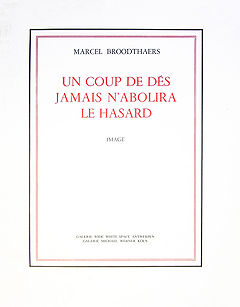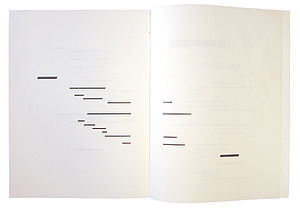
Un Coup de Dés Jamais N'Abolira Le Hasard (Broodthaers)
Encyclopedia

Marcel Broodthaers
Marcel Broodthaers was a Belgian poet, filmmaker and artist with a highly literate and often witty approach to creating art works....
published November 1969 in Antwerp. The work is a close copy of the first edition of the French Symbolist poet Stéphane Mallarmé's
Stéphane Mallarmé
Stéphane Mallarmé , whose real name was Étienne Mallarmé, was a French poet and critic. He was a major French symbolist poet, and his work anticipated and inspired several revolutionary artistic schools of the early 20th century, such as Dadaism, Surrealism, and Futurism.-Biography:Stéphane...
poem of the same name
Un Coup de Dés Jamais N'Abolira Le Hasard (Mallarmé)
Un Coup de Dés Jamais N'Abolira Le Hasard is a poem by the French Symbolist poet Stéphane Mallarmé...
, published in 1914, but with all the words removed, replaced by black stripes that correspond directly to the typographic layout used by Mallarmé to articulate the text.
"Broodthaers reduces Un Coup de Dés to its structure - or to put it another way he elevates the structure of the work to a concept worthy of study in its own right, thus acknowledging Mallarmé's own fetishistic attention to this aspect of his work. Rendering the structure concrete, visible, almost tactile, Broodthaers offers a conceptual analysis of Mallarmé's poem across the distance of a nearly a century...It would be hard to imagine a more subtle treatment of Mallarmé's work, or one more capable of demonstrating its essential properties, than this reworked book by Broodthaers." Johanna Drucker
Often included in exhibitions tracing the history of the artist's book, the work is seen as a seminal example of the European post-avant-garde. It is often referred to simply as Un Coup de Dés.
Mallarmé and Magritte
Broodthaers had lived in poverty as a poet in Brussels for twenty years before becoming an artist in 1964. His first exhibition, at the Galere Saint-Laurent, included two unsold parcels of his fourth book of poetry, Pense-Bête, encased in plaster. This was the first of many works that 'employed techniques associated with poetry but applied by him not only to words but to images and symbols.' Un Coup de Dés would become the most famous instance of Broodthaers' interest in setting up a contradiction between the written word and a visual image 'to the profit of the subject.'Broodthaers had been given a copy of Mallarmé's Un Coup de Dés in 1945 by the Belgian surrealist painter Réné Magritte
René Magritte
René François Ghislain Magritte[p] was a Belgian surrealist artist. He became well known for a number of witty and thought-provoking images...
as 'a way of explaining his art to a young admirer without explaining it literally.'
"As for the idea of establishing a direct relationship between literature and the plastic arts, I'm afraid I have done so by taking as a subject A Throw Of The Dice, by Mallarmé !!!" Broodthaers
Mallarmé had written the poem in 1897 and left copious notes as to how it should be typeset, instructions that were finally carried out 16 years after his death, in 1914. The poem was famous for its extraordinary typography, which anticipated the 20th century interest in graphic design
Graphic design
Graphic design is a creative process – most often involving a client and a designer and usually completed in conjunction with producers of form – undertaken in order to convey a specific message to a targeted audience...
and concrete poetry
Concrete poetry
Concrete poetry or shape poetry is poetry in which the typographical arrangement of words is as important in conveying the intended effect as the conventional elements of the poem, such as meaning of words, rhythm, rhyme and so on....
. Mallarmé was known to have organised the layout of the poem using rectangles of card, and to leave written pleas to publish the work exactly as he'd intended. As such, Broodthaers' work can be seen as a direct quote of Mallarmé's working methods and of his obsession with the visual layout of the text.
“Mallarmé is the source of all contemporary art... it unconsciously invents modern space”. Broodthaers 1970
The Literary Exhibition

'The word was 'there', more 'real', because three dimensional, than the original pages but, of course, negative and illegible. Meanwhile, the tape-recorded voice of the artist read out the poem repeatedly, it was 'there' but not simultaneously and continuously present like the words of the poem.'
The book
After a brief introduction citing the original edition published in 1914 by Librairie Gallimard, the book starts with the entire poem written as a block of text with each line separated by a slashSlash (punctuation)
The slash is a sign used as a punctuation mark and for various other purposes. It is now often called a forward slash , and many other alternative names.-History:...
(/). 12 double spreads follow, with immaculately laid out black rectangles standing in for the text. The work is soft bound and feels quite insubstantial. The cover is a near-perfect facsimile of the original cover, but with the word 'image' replacing 'poem' in the centre of the design.
The edition was published in Antwerp to coincide with the exhibition on 25 November 1969. 10 copies of the work - unbound, numbered I-X, printed on to 12 aluminium sheets - were made available, along with 90 copies printed on translucent paper and 300 copies on normal paper. The translucent edition came with two sheets of white card cut to the size of the book so that individual pages could be isolated by the reader if they so wished.
Reception of the book
The book, like Broodthaers' work in general, has gradually grown in stature since his death in 1976, and has found its way into a number of important collections, including MOMAMoma
Moma may refer to:* Moma , an owlet moth genus* Moma Airport, a Russian public airport* Moma District, Nampula, Mozambique* Moma River, a right tributary of the Indigirka River* Google Moma, the Google corporate intranet...
, V&A, and the Royal Academy of Fine Arts Antwerp
Royal Academy of Fine Arts Antwerp
The Royal Academy of Fine Arts Antwerp is an art academy located in Antwerp, Belgium. It is one of the oldest of its kind in Europe. It was founded in 1663 by David Teniers the Younger, painter to the Archduke Leopold Wilhelm and Don Juan of Austria...
.
External links
- A Throw of the Dice, translated by Christopher Mulrooney
- A Throw of the Dice, translated by Basil Cleveland
- Vispoets discussion board
- MOMA page on Un Coup De Dés
- A piece about the aborted Didot/Vollard edition of Mallarmé's Un Coup de Dés, including a photo of Mallarmé's typographic calculations.
- An e.book of Mallarmé's poem

